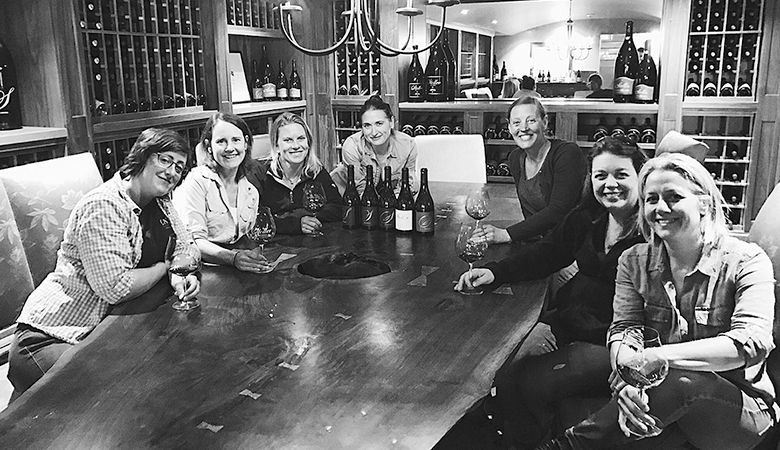Women in the Room
Winemakers encourage new generation
By Paul Omundson
Until recently, as in a decade ago, Lynn Penner-Ash, of Penner-Ash Wine Cellars, recalls arriving at Oregon winemakers’ events to discover she was often the only woman in the room — the only one, that is, who had winemaker credentials and was there on business. She wasn’t a participant’s companion or an aide. She was a bona fide wine professional.
You sense the resolve even today in Penner-Ash as she recalls those earlier years. “Some men at events like that pretty much assumed I, or any woman on hand, was only there socially, not as a participant,” she said. Over the years, she has also endured a similar sense of gender hierarchy when men assumed her parents gave her Penner-Ash Wine Cellars. “They can’t believe I started the winery [in 1998] along with Ron [Ash],” she said. “We did it equally, together. But there were men in the industry who felt a woman was incapable of doing something like that.”
Colleagues admire Penner-Ash for being one of the first women who, with sass and style, invaded this male-dominated territory. Cheryl Francis, co-founder of A to Z Wineworks, and a number of other rising female wine professionals followed, helping break down the barriers. Today, as a result, there is much better gender parity at Oregon professional wine gatherings across the board.
Penner-Ash couldn’t resist. She had a friend create a logo that stated “The Only Womaen in the Room” for an indication of how things were changing. The catchphrase “Women in the Room” became an overwhelming name choice when Francis, along with friend and confidant Anna Matzinger, co-owner and winemaker at Matzinger-Davies Wine Company, started an all-women’s wine tasting group. The two recruited Wynne Peterson-Nedry, winemaker of 00 Wines, RR and Ridgecrest Wines. The trio then reached out to Gina Hennen, winemaker at Adelsheim Vineyard, Kate Payne-Brown, winemaker at Stoller Family Estate, Luisa Ponzi, co-owner/winemaker of Ponzi Vineyards, and Penner-Ash.
“The Only Womaen in the Room” sign is proudly displayed wherever they gather for their monthly tastings.
Now these seven, ages ranging from 39 to 67, are locking arms to seek out ways each can guide and mentor a new generation of women emerging as winemakers and vineyard managers.
Facing headwinds
Francis puts it succinctly: “It’s our responsibility. We’ve been in the business a long time and have had great success. We have insights and knowledge to share with other women in our industry. Until we are an equal voice in the room, it’s necessary to have our own place to discuss professional issues that face us all. Women today encounter many of the headwinds we had to face earlier in our careers.”
The group has met for five years to examine and discuss everything, from new coopers and barrels to making black Chardonnay. But they also use their group as a platform for much more than swapping best practices in wine production. They’ve got each other’s back emotionally, no matter what the issue. That’s perhaps the main underlying benefit of the group. Each is here for the others.
It’s a nurturing model they want to share with the larger community of Oregon women winemakers and vineyard managers.
First order of business is identifying the individuals who make up the female side of wine production throughout Willamette Valley. To that end, the group hosted two get-to-know-you events last year, the first at Penner-Ash on International Woman’s Day, drawing 80 participants, with a follow-up session at A to Z Wineworks. Two gatherings are planned for this year, one before harvest in summer and one after in late fall.
From table talks and general discussions at the first two events, participants identified four broad areas they feel support is especially needed:
1) Maintaining quality of life and work/home balance. Production work means long, intense hours that go off the charts at harvest. How do women juggle those demands with family, home and friends?
2) Navigating a tight job market. A single cellar opening, when it does happen these days, can attract up to 80 résumés; concurrently internship opportunities seem to be dwindling. How do women get a foothold when none seems there?
3) Silo effect. The term describes the dangers of getting an isolated job in a small winery environment and working in a vacuum where there may be few individuals around for asking questions or bouncing ideas.
4) No room at the top. While there are some notable exceptions, there’s still proportionately far too few women executives, head winemakers and vineyard managers. Men continue to dominate winemaking and winegrowing.
Other issues are persistent as well, such as continuing gender inequity in wage and health benefits. But the group feels its efforts are best focused on the four challenges and related concerns. By end of year, Women in the Room hopes to develop tangible actions to address each of the four areas of concern.
There’s been several women wine support groups mushrooming recently and many have common goals. Women in the Room distinguishes itself by being an informal group with no paid staff, bylaws, dues or structure. Also, it focuses on winemakers and vineyard managers rather than women in the industry at large.
Here’s how Penner-Ash sums up the group and its key goal: “We’re self-run and self-funded. There’s no charge for our events. We have no help organizing and running these gatherings, so it’s not as formal and well-organized as some others,” she explains. “We’re just a bunch of winemakers trying to foster strong relationships between newer and more established women in the wine industry on the side of production and viticulture, which tends to be the more male-dominated sides of the industry.
“But not for long.”











